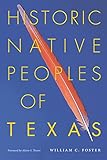Historic Native Peoples of Texas / William C. Foster.
Material type: TextPublisher: Austin : University of Texas Press, [2021]Copyright date: ©2008Description: 1 online resource (366 p.)Content type:
TextPublisher: Austin : University of Texas Press, [2021]Copyright date: ©2008Description: 1 online resource (366 p.)Content type: - 9780292794610
- 976.4/0497 22
- E78.T4 F67 2008eb
- online - DeGruyter
| Item type | Current library | Call number | URL | Status | Notes | Barcode | |
|---|---|---|---|---|---|---|---|
 eBook
eBook
|
Biblioteca "Angelicum" Pont. Univ. S.Tommaso d'Aquino Nuvola online | online - DeGruyter (Browse shelf(Opens below)) | Online access | Not for loan (Accesso limitato) | Accesso per gli utenti autorizzati / Access for authorized users | (dgr)9780292794610 |
Frontmatter -- Contents -- Foreword -- Preface -- Introduction -- 1 Between the Lower Brazos and the Lower Colorado Rivers -- 2 Between the Lower Colorado and the San Antonio Rivers -- 3 The Central Texas Coast -- 4 South Texas -- 5 The Texas Trans-Pecos -- 6 The Texas Southern Plains -- 7 Northeast Texas -- 8 The Upper Texas Coast -- 9 Conclusions -- Appendix 1. Selected Animals Reported on Spanish and French Expeditions into Texas, 1528–1722 -- Appendix 2. Selected Trees and Other Plants Reported on Spanish and French Expeditions into Texas, 1528–1722 -- Notes -- Bibliography -- Index
restricted access online access with authorization star
http://purl.org/coar/access_right/c_16ec
Several hundred tribes of Native Americans were living within or hunting and trading across the present-day borders of Texas when Cabeza de Vaca and his shipwrecked companions washed up on a Gulf Coast beach in 1528. Over the next two centuries, as Spanish and French expeditions explored the state, they recorded detailed information about the locations and lifeways of Texas's Native peoples. Using recent translations of these expedition diaries and journals, along with discoveries from ongoing archaeological investigations, William C. Foster here assembles the most complete account ever published of Texas's Native peoples during the early historic period (AD 1528 to 1722). Foster describes the historic Native peoples of Texas by geographic regions. His chronological narrative records the interactions of Native groups with European explorers and with Native trading partners across a wide network that extended into Louisiana, the Great Plains, New Mexico, and northern Mexico. Foster provides extensive ethnohistorical information about Texas's Native peoples, as well as data on the various regions' animals, plants, and climate. Accompanying each regional account is an annotated list of named Indian tribes in that region and maps that show tribal territories and European expedition routes. This authoritative overview of Texas's historic Native peoples reveals that these groups were far more cosmopolitan than previously known. Functioning as the central link in the continent-wide circulation of trade goods and cultural elements such as religion, architecture, and lithic technology, Texas's historic Native peoples played a crucial role in connecting the Native peoples of North America from the Pacific Coast to the Southeast woodlands.
Mode of access: Internet via World Wide Web.
In English.
Description based on online resource; title from PDF title page (publisher's Web site, viewed 26. Apr 2022)


